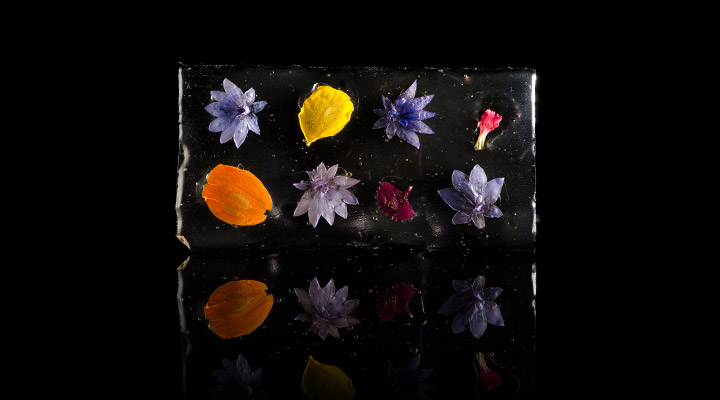Edible Flower Glass
This crunchy lychee glass with micro flowers was the result of a series of tests I ran to make flower paper and flower glass in multiple ways. And this was the best result of that experiment but at this point I think this is a concept that could still be improved.
At first I tried trapping micro flowers between two ultra-thin edible papers, spraying them with different liquors and dehydrating them for a few hours. I was hoping that the sugar content of the liquor will make them crispy after dehydrating. The resulting flower paper tasted good but it was sticky and not crispy. I tried increasing the dehydrating temperature but it only improved the result slightly.

I then dropped the ultra-thin edible paper idea entirely and tried making a croquant with kuzu starch and carefully arranged the micro flowers on top before placing in a dehydrator. The resulting glass was crunchy and transparent but was lacking flavor. To remedy this, I replaced the water in the croquant with lychee juice and problem fixed! The resulting flower glass was crunchy and the flavor of the lychee paired perfectly with the micro flowers.
During my tests I noticed that some micro flowers resisted the heat from the dehydrator better than others and maintained their appearance. Others shrunk and their color faded. So try with different micro flowers until you find the ones that maintain their appearance and taste good.
Another technique used by molecular gastronomy Chef Ferran Adria consists of trapping begonias, marigolds and herb flowers in cotton candy and compressing it to form an edible paper. The benefit of this technique is that it doesn’t require heat and all the flowers will look fresh and bright.
Ingredients
- 250 g (8.8 oz) clear lychee juice
- 20 g (0.8 oz) sugar
- 20 g Kuzu
- Assorted micro flowers
Preparation
Flower Glass
1- In a small pot, heat the lychee juice, sugar and kuzu over medium heat stirring constantly until it starts boiling. Let it boil for 30 seconds and remove from heat.
2- Pass the mix through a fine sieve to remove the small bubbles and pour it into a decorating bag.
3- Wait for 2 minutes to let it cool down.
4- Place stencil over Teflon or silicone mat. In this case I used a rectangular stencil. It is helpful to stick it with scotch tape to the countertop to keep it in place.
5- Pour some mix on the mat and spread it with an offset spatula creating a thin layer of about 0.3 cm.
6- Remove the stencil and carefully arrange the micro flowers on top of the kuzu layers using tweezers.
7- Place the mat in the dehydrator for 6 hours at 50 °C (122 °F).
8- Carefully remove the chips from the mat and flip them. Dehydrate for 18 hours at 50 °C (122 °F). The glass edges tend to bend upwards but to prevent this you can cover them with another silicone mat. The mat weight will keep them flat.
9- Once the flower glass is dry and crunchy, store them in a sealed container with desiccant packets in a dry and cool place.




 (3 votes, average: 4.67)
(3 votes, average: 4.67)
